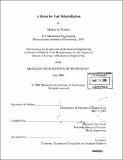A robot for gait rehabilitation
Author(s)
Roberts, Michael (Michael Henry), 1980-
DownloadFull printable version (17.45Mb)
Other Contributors
Massachusetts Institute of Technology. Dept. of Mechanical Engineering.
Advisor
Herman Igo Krebs.
Terms of use
Metadata
Show full item recordAbstract
After a stroke, persons suffer from neurological impairments that affect gait, and so require rehabilitation to regain ambulatory function. While 82% of patients recover the ability to walk, current methods including physiotherapy and partial body-weight supported treadmill training (PBWSTT) are monotonous and require intense therapist effort. The Mechanized Gait Trainer and the LOKOMAT are two robotic devices that have been developed to improve gait rehabilitation, but neither provides the facilitation of pelvis movements afforded by traditional methods. In addition, neither device is truly backdrivable. As shown by Hogan and Krebs, backdrivable, impedance-controlled robots are ideal for rehabilitation because of their stable interaction properties. Robots for the arm/shoulder, wrist, ankle, and hand have already been developed. This thesis describes the design of a robot for gait rehabilitation through the facilitation of pelvis movements. Four degrees of freedom (DOF) are actuated: vertical, lateral, and frontal translations as well as the rotation about the vertical axis. Vertical forces support part of the patient's weight. Lateral forces assist the weight shift from stance leg to swing leg and are a part of physiotherapy and treadmill training. (cont.) Frontal forces help pace the subject as on a treadmill. Pelvic rotations can impart energy into the swing leg without direct actuation of the hip and knee muscles. A four DOF mechanism was designed to control these movements, consisting of a three-DOF planar linkage with a vertical prismatic translation. A mockup of the configuration was designed and tested to show that the non-actuated pelvis DOFs are not adversely affected by the device. Design calculations include finding the optimal linkage configuration, selecting ballspline shafts for the vertical DOF, selecting actuators, and designing the robot arm cross-sections and joints. A final design for the four-DOF module is presented.
Description
Thesis (S.M.)--Massachusetts Institute of Technology, Dept. of Mechanical Engineering, 2004. Includes bibliographical references (p. 216-220).
Date issued
2004Department
Massachusetts Institute of Technology. Department of Mechanical EngineeringPublisher
Massachusetts Institute of Technology
Keywords
Mechanical Engineering.